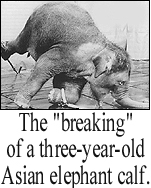|
Stop Circus Cruelty
The circus paints a picture of happy animals doing tricks because they like to. The fact is, that animals in the circus endure pain and abuse for the sake of entertainment. In nature, bears don't ride bicycles, elephants don't stand on their heads and a tiger would never hop on his hind legs. To force wild animals to perform these silly acts, trainers use whips, muzzles, electric prods and bullhooks. The circus forces them to perform night after night, for 48 to 50 weeks every year. Between acts, elephants are kept in chains and tigers are stored in cages with barely enough room to take one step. Ringling has also invented a "unicorn" by mutilating a baby goat and sugically having his horns to the center of his forehead.
Most elephants used by circuses were captured in the wild. Once removed from their families and natural habitat, their lives consist of little more than chains and intimidation. Baby elephants born in breeding farms are torn from their mothers, tied with ropes and kept in isolation until they learn to fear their trainers. In order to "tame" them, they are "broken". Some trainers have used bulldozers to get the chained elephants attention...
to teach them a lesson. Sometimes the elephants die, but never quickly. It takes a long time for an animal the size of an elephant to die and sometimes the elephants don't die....
Here is a picture of an unnamed three year old elephant, chained, pulled, confined in an unnatural position, denied food, water, shelter, dignity, beaten with bullhooks, baseball bats, iron bars and wooden axe handles. I hate that this happens and I hate this picture but sometimes a picture wakes our emotions enough to wakes us up to what's going on around us. |
|
|
Tribute to Black Diamond & Tyke
On October 12, 1929, a majestic bull elephant named Black Diamond was among a procession of animals being marched from a rail yard to the circus grounds in Corsicana, TX. A crowd had gathered to watch the parade. While the elephants stopped and lined up near a fire hydrant waiting their turn for a drink of water, a female spectator wishing to pet the enormous Black Diamond, approached him. In a matter of moments, Black Diamond knocked her to the ground, gored her to death, destroyed a parked car and injured two trainers. Days later, owner John Ringling ordered Black Diamonds execution. They began debating the killing method for Black Diamond. Some suggested that Black Diamond's feet be bound with tons of lead and that he be dragged by tugboat into the Gulf of Mexico and left to drown. Others thought that chains should be wrapped around his neck and the other ends shackled to his fellow elephants who would be forced to slowly strangle him to death. Others recommended electrocution. Ultimately, his executioners decided on poison. When the circus arrived in Kennedy, TX, Black Diamond was led away to a forest clearing and chained between two trees. He refused to eat the poison laced peanut shells and oranges. A volunteer firing squard of 20 men took aim and pumped over 170 bullets into Black Diamond. Black Diamond's bullet riddled head was chopped off and mounted for display in Houston, TX.
In another incident that occurred on August 20, 1994 in Hawaii, Tyke a circus elephant went on a rampage and trampled her trainer and a groomer to death. She was then shot with approximately 80 bullets by police in the street and left crying and in pain for two hours until she died. She was "buried" in a landfill afterward. Please click on her picture below to view the video of her death and the treatment of circus elephants. *Warning: very graphic.
|
|
"Tools" of the Trade
CHAINS: Elephants are chained by one or both front and hind legs during training sessions, transport and often between shows. Inadequate exercise and prolonged standing in wet, unsanitary conditions may lead to foot rot and other painful foot conditions.
ROPES: Baby elephants born in breeding are prematurely removed from their mothers for training. They are kept isolated and tied with ropes at their front and back legs. Rope burns may develope as they strain against their restraints.
WHIPS: The sting of a whip causes lingering and intense pain.
ELECTRICAL SHOCK: Circuses often use electric prods and smaller handheld devices that are easily concealed. Like the whip, a jolt of electrical current is painful.
STICKS, AXE HANDLES, BASEBALL BATS, METAL PIPES: These weapons are used to hit and beat restrained animals in order to break them of their spirit and show them "who's boss."
CIGARETTE LIGHTERS: Often used to burn the paws of tigers and other big cats to force them to stand on their hind legs.
|
|


